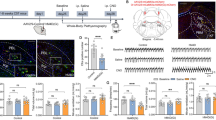Abstract
To further examine the role of central catecholamine and 5-hydroxytryptamine neurones on affective-type aggressive behavior, the effects of carbachol, muscarine, eserine, and neostigmine on 6-hydroxydopamine-and reserpine-treated cats were examined. Carbachol, muscarine, eserine, and neostigmine, injected into the cerebral ventricles of control conscious cats, evoked emotional behavior with aggression, autonomic, and motor phenomena with clonic-tonic convulsions. The most impressive feature of the gross behavioral effects of intraventricular cholinominetics and anticholinesterase was affective-type aggression. Intraventricular 6-hydroxydopamine and reserpine, as well as parenterally administered reserpine, carbachol, muscarine, eserine, and neostigmine, elicited aggression, autonomic, and motor phenomena with clonic-tonic convulsions. Of affective-aggressive behavior, the biting attack was the most apparent, while hissing and snarling (i.e., vocalization) were depressed or absent. The most resistent to 6-hydroxydopamine and reserpine were the manifestations of affective-aggressive behavior caused by muscarine. The autonomic phenomena were of mild intensity. We conclude that intact central catecholamine and 5-hydroxytryptamine networks are required for expression of emotional behavior, especially vocalization (hissing and snarling), in affective-type aggression. However, intact central catecholamine and 5-hydroxytryptamine pathways are not needed for the performance of attack and biting phenomena.
Similar content being viewed by others
References
Beleslin, D. B., Grbović, L., Radamanović, B. Ž.: The pharmacology of gross behavioral effects of cholinomimetic substances injected into the cerebral ventricles of unanaesthetized cats: evidence for central muscarinic mediation. Neuropharmacology 13, 1163–1169 (1974)
Beleslin, D., Samardžić, R.: Analyse pharmalogique de l'action de l'ésérine et de la néostigmine injectées dans le ventricule cérébral sur le comportement général du chat conscient. J. Pharmacol. (Paris) 7, 203–210 (1976)
Beleslin, D. B., samardžić, R.: Muscarine- and carbachol-induced aggression: fear and irritable kinds of aggressions. Psychopharmacology 55, 233–236 (1977)
Beleslin, D. B., Samardžić, R.: Comparative study of aggressive behaviour after injection of cholinomimetics, anticholinesterases, nicotinic and muscarinic ganglionic stimutants into the cerebral ventricles of conscious cats: failure of nicotinic drugs to evoke aggression. Psychopharmacology (in press, 1978a)
Beleslin, D. B., Samardžić, R.: The pharmacology of aggressive behavioral phenomena elicited by muscarine injected into the cerebral ventricles of conscious cats. Psychopharmacology (in press, 1978b)
Beleslin, D. B., Samardžić, R.: Evidence of central cholinergic mechanisms in the appearance of affective aggressive behaviour: dissociation of aggression from autonomic and motor phenomena. Psychopharmacology (in press, 1979a)
Beleslin, D. B., Samardžić, R.: Effects of parachlorophenylalanine and 5,6-dihydroxytryptamine on aggressive behaviour evoked by cholinomimetics and anticholinesterases injected into the cerebral ventricles of conscious cats. Neuropharmacology (in press, 1979b)
Bloom, F. E., Algeri, S., Groppetti, A., Revuelta, A., Costa, E.: Lesions of central norepinephrine terminals with 6-OH-dopamine: biochemistry and fine structure. Science 166, 1284–1286 (1969)
Eichelman, B. S., Thoa, N. B., Ng, K. Y.: Facilitated aggression in the rat following 6-hydroxydopamine administration. Physiol. Behav. 8, 1–3 (1972)
Feldberg, W., Sherwood, S. L.: A permanent cannula for intraventricular injection in cats. J. Physiol. (Lond.) 120 3–4P (1953)
Holzbauer, M., Vogt, M.: Depression by reserpine of the noradrenaline concentration in the hypothalamus of the cat. J. Neurochem. 1, 8–11 (1956)
Iversen, L. L.: Inhibition of catecholamine uptake by6-hydroxydopamine in rat brain. Eur. J. Pharmacol. 10, 408–410 (1970)
Jimerson, D., Reis, D.: Effects of intrahypothalamic injection of 6-hydroxydopamine on predatory aggression in rats. Brain. Res. 61, 141–142 (1973)
Karli, P., Vergnes, M.: Dissociation expérimentale du comportement d'aggression interspécifiques Rat-Souris et du comportement alimentaire. C.R. Soc. Biol. (Paris) 158, 650–653 (1964)
Lewis, P. J., Rawlins, M. D., Reid, J. L.: The effects of intraventricular 6-hydroxydopamine on body temperature and arterial blood pressure in cats and rabbits. Br. J. Pharmacol. 51, 207–212 (1974)
Miczek, K. A., Barry, H.: Pharmacology of sex and aggression. In: Behavioral pharmacology, G. D. Glick, J. Goldfarb, eds., pp. 176–257. S. Louis: Mosby 1976
Myers, R. D.: Handbook of drug and chemical stimulation of the brain. Behavioral, pharmacological and physiological aspects. New York: Van Nostrand Reinhold 1974
Nakamura, K., Thoenen, H.: Increased irritability: a permanent behavior change induced in rat by intraventricular administration of 6-hydroxydopamine. Psychopharmacologia 24, 359–372 (1972)
Panksepp, J.: Effect of hypothalamic lesions on mouse-killing and shock-induced fighting in rats. Physiol. Behav. 6, 311–316 (1971)
Pletscher, A., Shore, P. A., Brodie, B.: Serotonin release as a possible mechanism of reserpine action. Science 122, 374–375 (1955)
Reis, D. J.: The chemical coding of aggression in brain. In: Neurohumoral coding of brain functions. R. D. Myers, R. R. Drucker-Colin, eds., pp. 125–150. New York: Plenum Press 1974
Sorenson, C. A., Ellison, G. D.: Nonlinear changes in activity and emotional reactivity scores following central noradrenergic lesions in rats. Psychopharmacologia 32, 313–325 (1973)
Thoa, N. B., Eichelman, B., Ng, K. Y.: Aggression in rats treated with dopa and 6-hydroxydopamine. J. Pharm. Pharmacol. 24, 337–338 (1972)
Uretsky, N. Y., Iversen, L. L.: Effects of 6-hydroxydopamine on catecholamine containing neurones in the rat brain. J. Neurochem. 17, 269–278 (1970)
Author information
Authors and Affiliations
Rights and permissions
About this article
Cite this article
Beleslin, D.B., Samardžić, R. Effects of 6-hydroxydopamine and reserpine on aggressive behavior induced by cholinomimetic and anticholinesterase injections into cerebral ventricles of conscious cats: Dissociation of biting attack from snarling and hissing. Psychopharmacology 61, 149–153 (1979). https://doi.org/10.1007/BF00426729
Received:
Issue Date:
DOI: https://doi.org/10.1007/BF00426729




